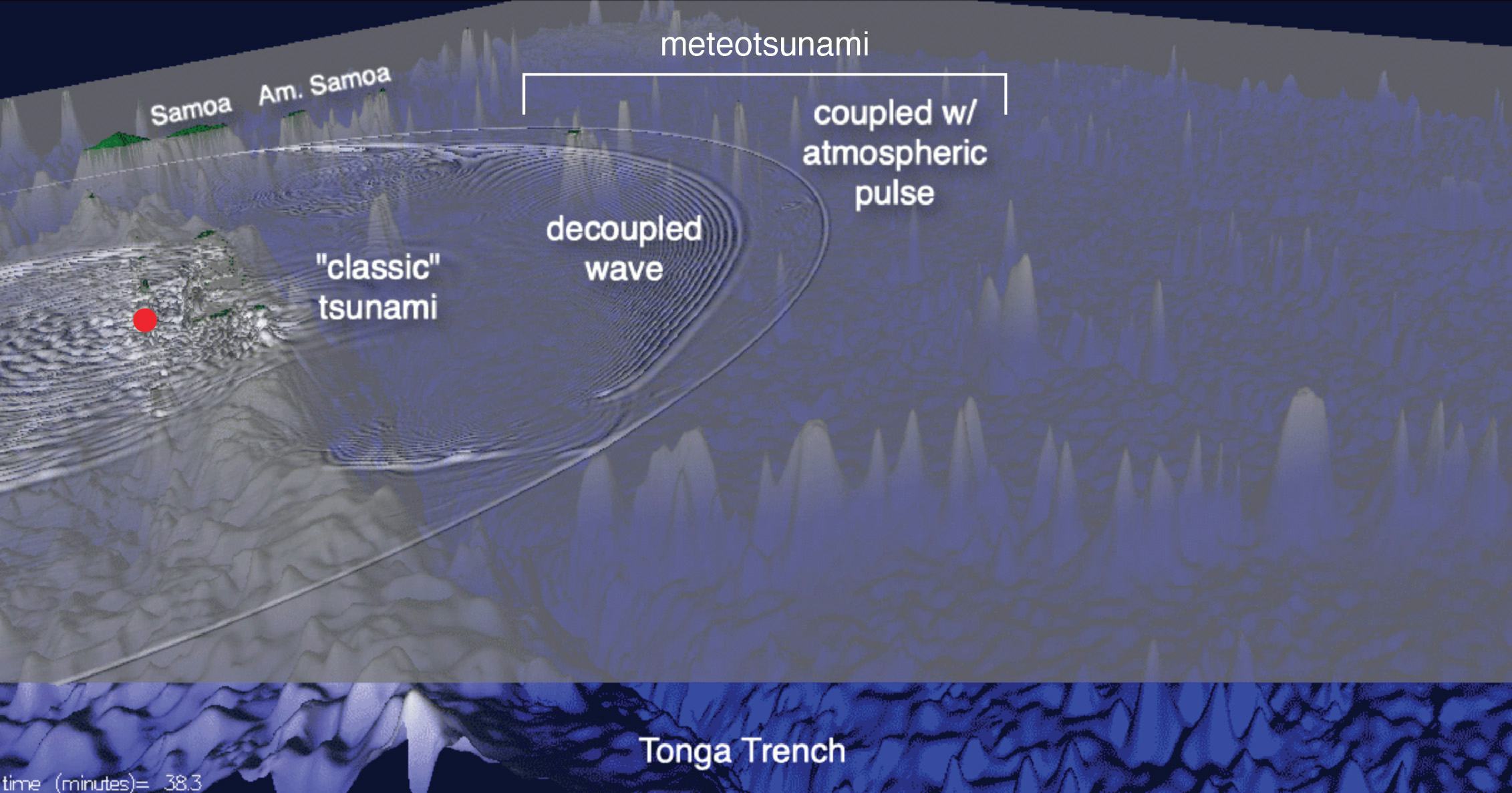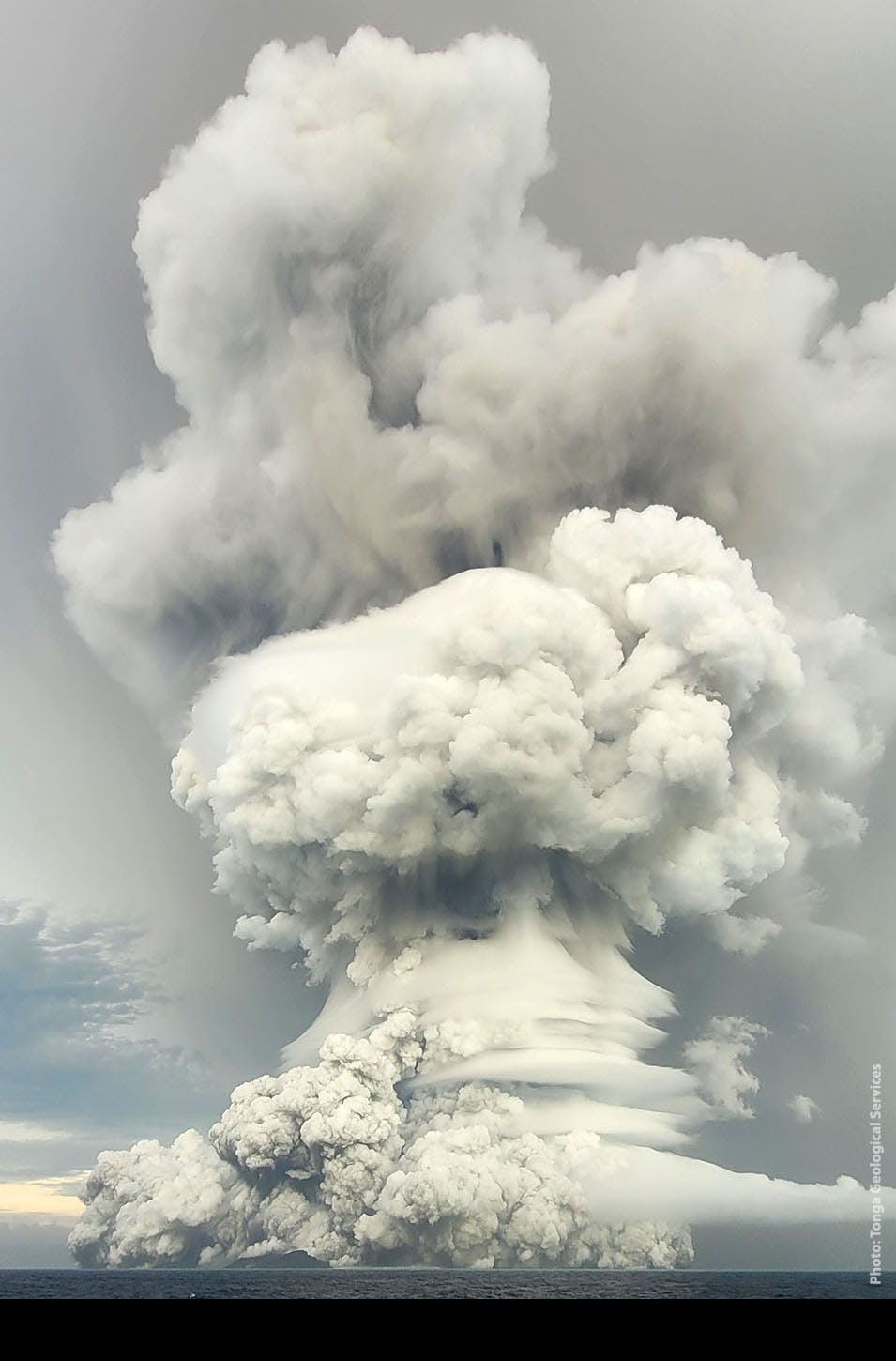
Volcanic eruptions displace air, land, and water in their wake, and according to a new study, they also tickle the atmosphere. A group of Japanese researchers has found this high-altitude signature may warn people several hours in advance about tsunamis barreling toward them.
On January 15, the Kingdom of Tonga’s Hunga Tonga–Hunga Haʻapai volcano in the Pacific Ocean unleashed a violent eruption as potent as up to 18 megatons of TNT. This explosion triggered an acoustic shockwave that spread across Earth, which produced a worrisome tsunami that traveled faster than those created more directly by the eruption.
In a new study published in the journal Earth, Planets and Space, atmospheric researcher Atsuki Shinbori explains how a vertical shockwave left an imprint on the ions floating more than 50 miles above Earth’s surface, and sent an early alert to some instruments in Japan ahead of the first tsunami wave triggered by the largest atmospheric explosion in human history.
Shinbori — who works at the Institute for Space-Earth Environmental Research at Nagoya University in Japan — tells Inverse that, if his findings lead to a detection approach, “it may be possible to estimate the size of [a] tsunami, such as height … several hours before it arrives.”
The eruption’s puzzling waves
“The Tonga tsunami was characterized by a uniformly small leading wave that arrived earlier than theoretically expected for a tsunami wave freely propagating away from the volcano,” Matías Carvajal, associate professor at the Institute for Geography at Pontifical Catholic University of Valparaíso in Chile, writes in a March 2022 study.
The largest waves then followed this first one, and they were up to three meters high. According to a model the U.S.Geological Survey (USGS) developed of how the waves spread northward from the volcano, there are roughly three types of waves: the first two are generated by the atmospheric blast and the last ones are the product of the eruption’s vibrations in the sea. The U.S. National Oceanic and Atmospheric Administration (NOAA) admits that these types of air-generated waves, called meteotsunami, are not very well understood. That’s a problem when the catalyst of these ominous crests is pressure blasting out at the speed of sound.

But fortunately, something is faster than sound: the speed of light.
It appeared out of nowhere
“Volcanic tsunamis of this magnitude are very rare,” Carvajal tells Inverse. “The last one that seems to be similar occurred in the 19th century, in 1883, in Indonesia.”
The catastrophic 1883 eruption was Krakatau, which killed 36,000 people, destroyed hundreds of villages, and produced a thick blanket of ash and pumice that plunged the planet into darkness. NOAA says it took five years for things to return to normal. Its descendant volcano, Anak Krakatau, also left a horrid wake when it erupted in December 2018. It killed at least 430 people. The tsunami it triggered left thousands of people injured or missing.
These catastrophes have been hard to predict because they are rare. Carvajal admits that the power of the January 15 atmospheric shockwave was a surprise.
“Until January, it was thought that the main sources or mechanisms of tsunami generation, associated with a volcanic eruption, had to do with processes that happened right there in the volcano,” he says.

“For example, we thought that the sudden collapse of the volcano's caldera or the submarine explosion were the main mechanisms of volcanic tsunami generation, since both processes are theoretically capable of displacing large volumes of water.” This is what happened in 2018: a flank of Anak Krakatau’s caldera fell into the sea to create an initial wave that was 43 meters tall.
The danger of an eruption’s atmospheric waves is not unheard of, but Carvajal thinks it has not received a lot of attention. He says the 2022 Tonga eruption “demonstrated, once again, that our knowledge regarding tsunami generation is far from complete.”
Aside from the atmospheric mechanics, the eruption itself came out of nowhere. Even a 38-year veteran like Jim Garvin, a chief Earth and planetary scientist at NASA, tells Inverse that Hunga Tonga–Hunga Haʻapai was not expected to erupt for centuries.

What’s faster than sound?
Shinbori made a potentially life-saving finding.
When Hunga Tonga–Hunga Haʻapai volcano erupted, it created sound waves. Some of these waves shot straight up, reached space, and left an imprint on the sunlit charged particles of the ionosphere. This imprint then traveled along Earth's magnetic field lines, running South to North. Shinbori describes these like the conducting wires of an electric generator, which carries electricity at roughly the speed of light.
Instruments in Japan noticed this ionospheric imprint — an electric field — before their other instruments detected the air shock of the tsunami, and before other instruments detected water waves from the tsunami. The size of the electric field corresponds to the strength of the shockwave, so it can also give scientists an estimate of the inbound tsunami wave size.
What’s to come in the future
Scientists may not receive that type of early ionospheric signal during a nighttime eruption.
“The sunlight affects the signals of ionospheric disturbances,” he tells Inverse, explaining that their amplitude decreases when ions are in a shadow. At night, “there is a possibility that we cannot distinguish a tsunami's origin from other sources,” he says.
Shinbori wants to analyze more data in the future to see how this technique could be fine-tuned. He hopes to one day establish an ionospheric warning system that can reveal menacing volcanic tsunami at any time of day, earlier than what deep water buoys and satellites can currently relay.







